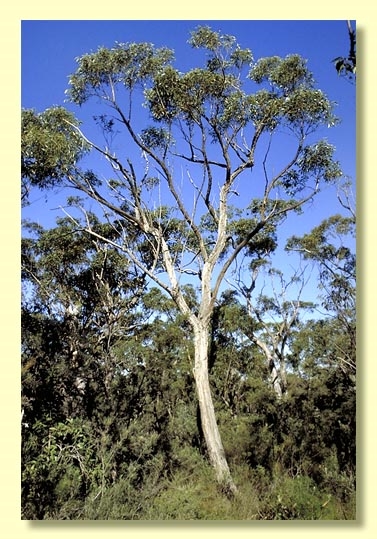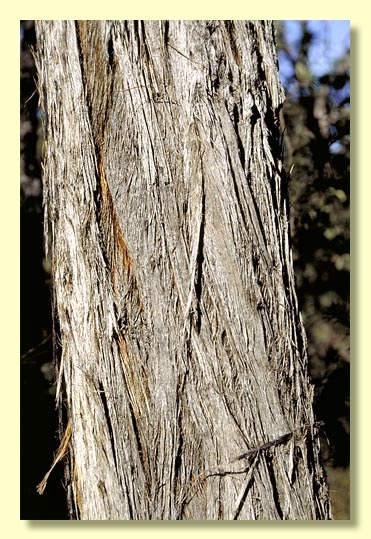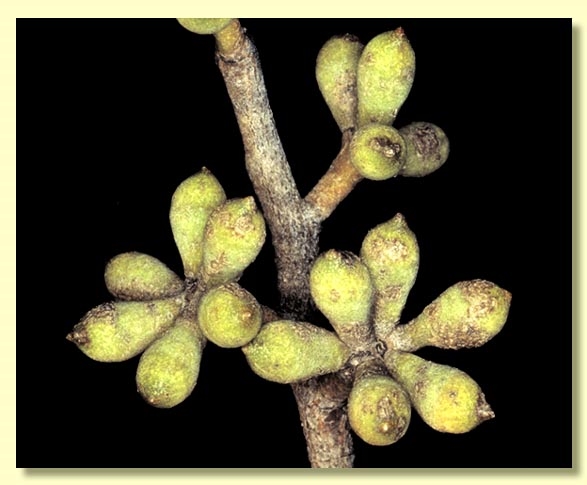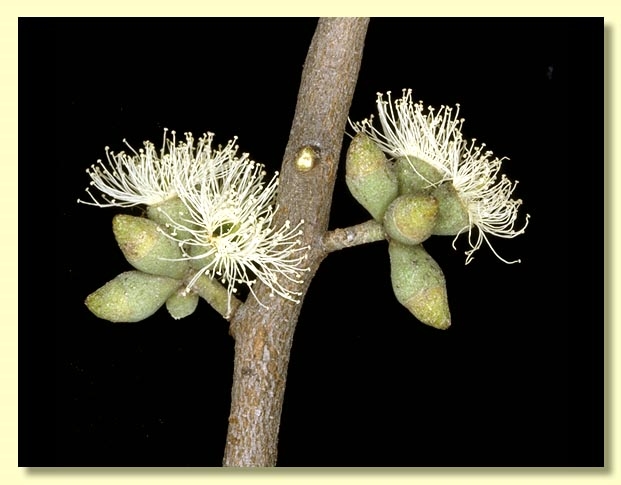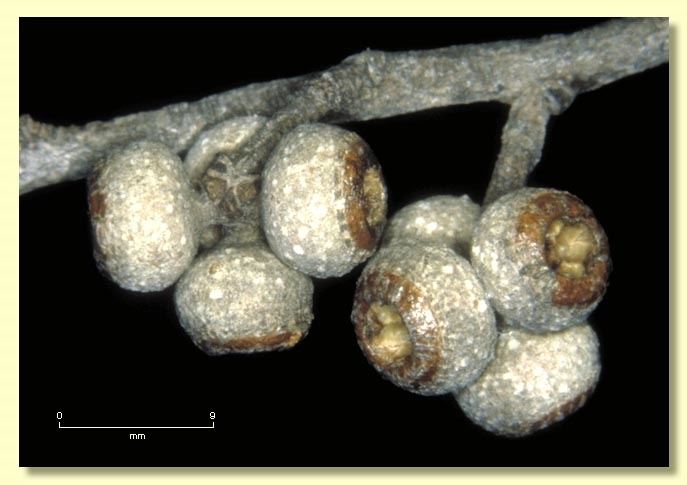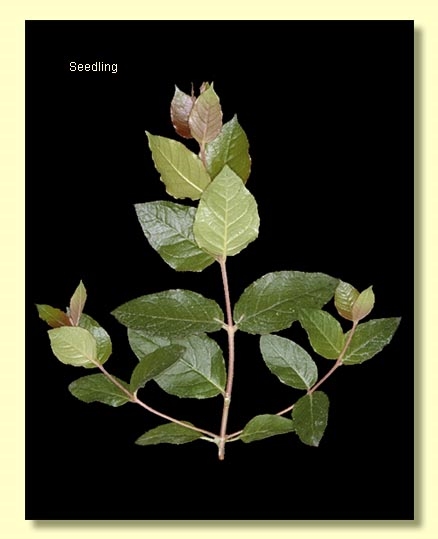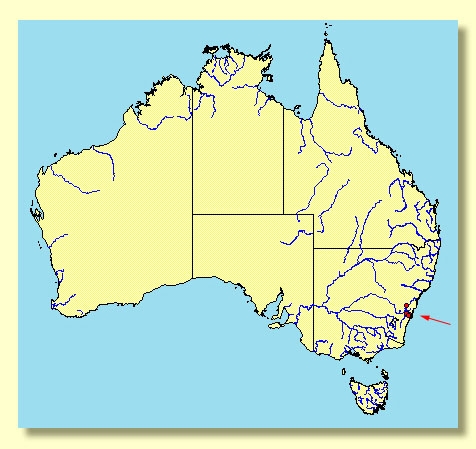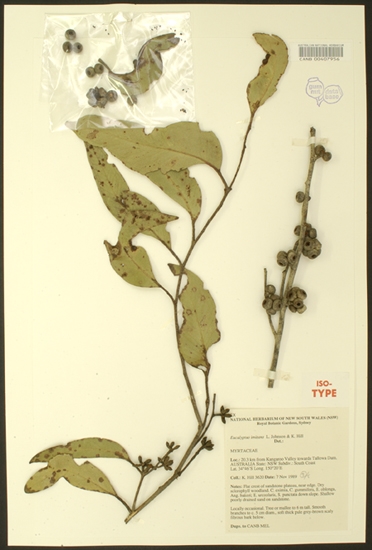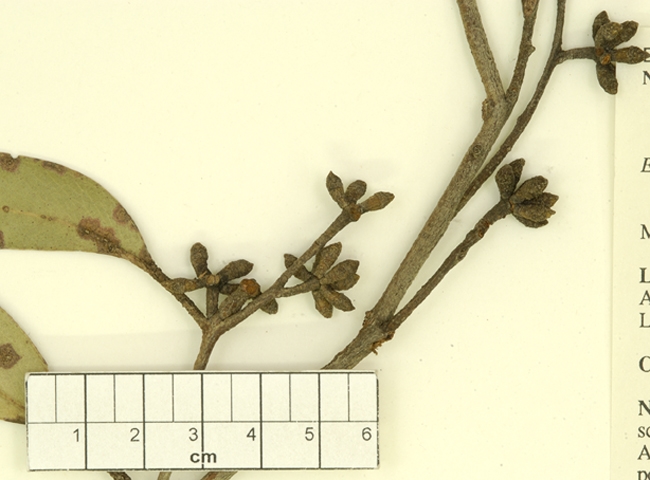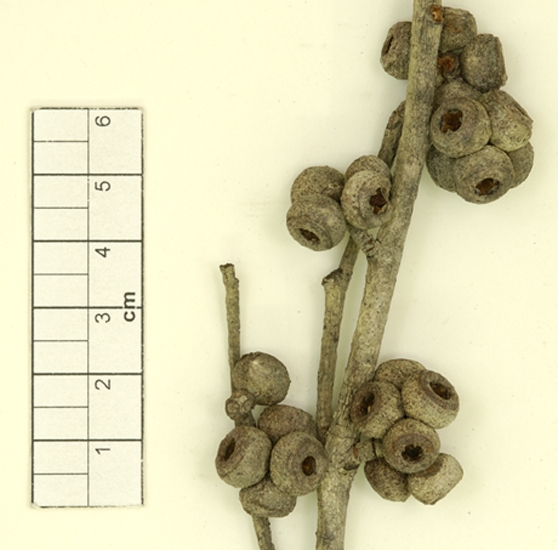Euclid - Online edition
Eucalyptus imitans
Eucalyptus | Eucalyptus | Capillulus | Pachyphloius
Bark rough to 5 cm diameter branches, stringy, pale grey to grey-brown.
Juvenile growth (coppice or field seedlings to 50 cm): stem rounded in cross-section, scabrid to ca node 10–12; juvenile leaves subsessile to shortly petiolate and opposite for 4 to 6 pairs then alternate, petiolate, ovate to elliptical, 2.5–11 cm long, 1.2–5.5 cm wide, margin slightly undulate and irregular becoming entire, glossy, green; petiole and lamina scabrid on both surfaces for at most 10 pairs, often fewer.
Adult leaves alternate, petiolate, petiole 0.7–1.8 cm long; blade lanceolate to elliptical to ovate or falcate, 5–13 cm long, 1.5–3.5 cm wide, base usually oblique, thick-textured, concolorous, glossy, green, coriaceous, side-veins acute, reticulation absent, intramarginal vein parallel to and remote from margin, oil glands island, irregular in shape.
Inflorescence axillary unbranched, peduncles 0.5–1.2 cm long, buds in umbels of 9 to 15, sessile or the pedicel to 0.3 cm long. Mature buds ovoid to diamond-shaped, 0.6–0.7 cm long, 0.3–0.4 cm wide, green, smooth, warty or scurfy, scar absent, operculum usually obtusely conical, stamens irregularly flexed, anthers reniform to cordate, versatile, dorsifixed, dehiscing by confluent slits, style long, stigma tapered, locules 3 or 4, the placentae each with 2 vertical ovule rows. Flowers white.
Fruit sessile or on pedicels 0.1 cm long, hemispherical or shortly truncate-globose, 0.4–0.6 cm long, 0.7–1.2 cm wide, disc raised-convex or oblique, or disc level, valves 3 or 4, enclosed, near rim level or slightly exserted.
Seeds brown or blackish, 1.3–2.5 mm long, pyramidal or obliquely pyramidal, dorsal surface smooth, hilum terminal.
Cultivated seedlings (measured at ca node 10): cotyledons reniform; stems rounded in cross-section, stellate-hairy; leaves always at least shortly petiolate, opposite for 4 to 6 nodes then alternate, ovate, 4.5–10 cm long, 2–5.5 cm wide, base rounded or slightly lobed, margin irregular and undulate, apex pointed, slightly discolorous, glossy, mid-green. Leaves sparsely to moderately stellate-hairy on upper and lower surfaces.
Flowering has been recorded in May, June, October, November and December.
A small stringybark tree, endemic to New South Wales, which occurs on subcoastal plateaus on shallow sand over sandstone, in the country west of Kangaroo Valley to Nowra particularly on the roads to Tallowa Dam and to Yalwal, and near Wingello and Bundanoon, on infertile white sandy soil. Eucalyptus imitans has rough bark over the trunk and larger branches, thick-textured and fairly small glossy green adult leaves, pointed buds that are often scurfy or warty, usually sessile and more or less hemispherical fruit, and broadly ovate juvenile leaves that are scabrid only at the lowest nodes, soon becoming glabrous.
Within its limited natural range E. imitans is distinctive because of the bark characters mentioned above, bud and adult and juvenile leaf features. E. blaxlandii is similar in having smooth-barked branches but has blunt, not pointy, buds that are never scurfy.
E. imitans is closely related to E. baxteri, sharing bud and juvenile leaf characteristics,and occupies similar poor sandy sites. The buds of E. imitans have a more pointed operculum, whilst E. baxteri has a rounded operculum and can have larger fruit (to 1.6 cm diameter). Eucalyptus baxteri is found from the Eden area of southern New South Wales west through Victoria south of the Great Dividing Range to the Mount Lofty Range and Kangaroo Island in South Australia.
MORE ABOUT STRINGYBARKS

